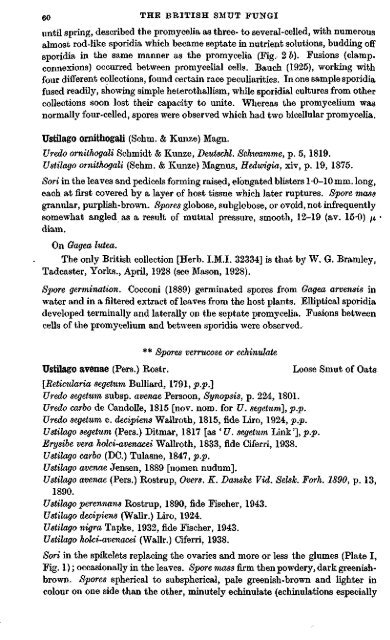nmm sP
nmm sP
nmm sP
You also want an ePaper? Increase the reach of your titles
YUMPU automatically turns print PDFs into web optimized ePapers that Google loves.
60 THE BRITISH SMUT FUNGI<br />
until spring, described the promycelia as three- to several-celled, with numerous<br />
almost rod-like sporidia which became septate in nutrient solutions, budding o£f<br />
sporidia in the same manner as the promycelia (Fig. 2 b). Fusions (clampconnexions)<br />
occurred between promycelial cells. Bauch (1925), working with<br />
four different collections, found certain race peculiarities. In one sample sporidia<br />
fused readily, showing simple heterothallism, while sporidial cultures from other<br />
collections soon lost their capacity to unite. Whereas the promycelium was<br />
normally four-ceUed, spores were observed which had two bicellular promycelia.<br />
Ustilago omithogali (Schm. & Kunze) Magn.<br />
Uredo omithogali Schmidt & Kunze, Deutschl. Schwamme, p. 5, 1819.<br />
Ustilago omithogali (Schm. & Kunze) Magnus, Hedwigia, xiv, p. 19, 1875.<br />
Sori ia the leaves and pedicels forming raised, elongated blisters 1-0-10 mm. long,<br />
each at first covered by a layer of host tissue which later ruptures. Spore mass<br />
granular, purphsh-brown. Spores globose, subglobose, or ovoid, not infrequently<br />
somewhat angled as a result of mutual pressure, smooth, 12-19 (av. 15-0) /i •<br />
diam.<br />
On Gagea lutea.<br />
The only British collection [Herb. I.M.I. 32334] is that by W. G. Bramley,<br />
Tadcaster, Yorks., April, 1928 (see Mason, 1928).<br />
Spore germination. Cocconi (1889) germinated spores from Gagea arvensis in<br />
water and in a filtered extract of leaves from the host plants. Elliptical sporidia<br />
developed terminally and laterally on the septate promycelia. Fusions between<br />
cells of the promycelium and between sporidia were observed.<br />
** Spores verrucose or echinulate<br />
Ustilago avenae (Pers.) Rostr. Loose Smut of Oats<br />
[Reticularia segetum BuUiard, 1791, p.p.]<br />
Uredo segetum subsp. avenae Persoon, Synopsis, p. 224, 1801.<br />
Uredo carbo de Candolle, 1815 [nov. nom. for U. segetum], p.p.<br />
Uredo segetum e. decipiens Wallroth, 1815, fide Liro, 1924, p.p.<br />
Ustilago segetum (Pers.) Ditmar, 1817 [as ' U. segetum Link'], p.p.<br />
Erysibe vera holci-avenacei Wallroth, 1833, fide Ciferri, 1938.<br />
Ustilago carbo (DC.) Tulasne, 1847, p.p.<br />
Ustilago avenae Jensen, 1889 [nomen nudum].<br />
Ustilago avenae (Pers.) Rostrup, Overs. K. Danske Vid. Selsk. Forh. 1890, p. 13,<br />
1890.<br />
Ustilago perennans Rostrup, 1890, fide Fischer, 1943.<br />
Ustilago decipiens (Wallr.) Liro, 1924.<br />
Ustilago nigra Tapke, 1932, fide Fischer, 1943.<br />
Ustilago holci-avenacei (Wallr.) Ciferri, 1938.<br />
Sori in the spikelets replacing the ovaries and more or less the glumes (Plate I,<br />
Fig. 1); occasionally in the leaves. Spore mass firm then powdery, dark greenishbrown.<br />
Spores spherical to subspherical, pale greenish-brown and lighter in<br />
colour on one side than the other, minutely echinulate (echinulations especially

















